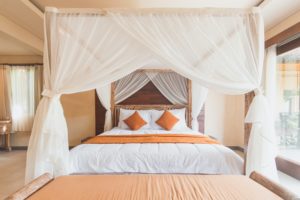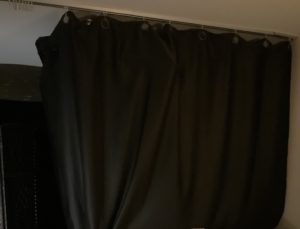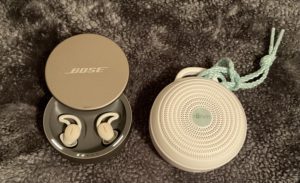My bedroom is my rendition of a cave: cool, dark, and quiet. Does your sleep space have similar conditions? Here are a few simple and creative ways that may help improve your sleep environment.
Even as a sleep researcher, I have struggled with consistently sleeping well. I would sleep through the night sometimes, but loud cars or early sunlight would often wake me up. One thing that I changed to improve my sleep pattern is my bedroom environment. Sleep experts typically agree that the sleep space should be like a cave: cool, dark, and quiet. In a small apartment near constant city noise, with a bedroom that doubles as an office, I forged these conditions. To achieve a cave-like sleep environment, I used blackout curtains, white noise machines, and dividers.
Each component of this setup is important and can be easily achieved using several different methods. With a little creativity, you can transform your sleeping environment into your ideal sleep space. Let’s do a quick audit of your bedroom.
The Bedroom Audit
Is your bedroom a comfortable temperature?
A warm room is unideal for sleep. Research has shown that heat exposure can prolong sleep onset, or the time it takes to fall asleep. A warm environment is also linked with greater sleep disruption. In comparison to heat exposure, cold exposure does not negatively affect sleep. The recommended ambient temperature during sleep is between 60 to 67 degrees Fahrenheit (15.6 to 19.4 degrees Celsius).
Turning down the air condition is one way to create a cool environment. However, using the air condition at such low temperatures can be costly. There are several cheaper alternatives to air condition. For example, placing a box fan near the bed can provide a cooling effect at a fairly low cost. In some climates, simply opening a window may suffice to cool the room. Differing from these two options, you may elect to more directly change the temperature within the bed itself. There is commercially available bedding that allows for cooler temperatures. Specifically, cooling pillows, sheets, and bedding with more breathable fabric may help create a cool, cave-like environment.
Is there any light in the bedroom?
Light exposure during the day hours promotes better sleep quality at night, especially during the morning hours. However, evening light exposure may delay sleep initiation. In other words, it may take longer to fall asleep in a well-lit bedroom or after viewing a backlit devices (e.g, mobile phone, laptop, tablet) as compared to a dark bedroom. If you need to see in your bedroom (e.g., to light the path to the bathroom), warm light tends to be better for sleep than cool light.
Sometimes the light in our bedrooms comes from outside sources such as street lights, porch lights, or headlights from passing cars. We can block the light using several methods. The most economical and simplest approach is to use an eye mask when you go to bed. However, you should be sure that the eye mask is a comfortable one that you will want to wear for the full duration of the night. An additional method is to dim the light from the external environment. For example, blackout curtains can be purchased at a reasonable price and sufficiently darken the bedroom. To ensure a dark environment, blackout curtains can be layered. Instead of blackout curtains, you could use room dividers to block incoming light from the sleep space. This may be the best option for small and open concept apartments or shared spaces (e.g., living with a roommate). Room dividers are often portable and act as a simple method to separate sleep spaces from environments meant for other purposes.
Investing in a canopy-style bed may be the most expensive method to darken the bedroom, as drapes surround the perimeter of the bed (see example below). If these drapes do not effectively block external light, they can be replaced with blackout curtains. If you want a canopy-like bed, but do not want to invest in a new bed frame, you could do what I did (image below). You can enclose your bed with a hanging room divider.


Are there startling noises when you sleep?
Living in a city makes for constant noise, especially from motor vehicles and sirens. Some of us may have to deal with noisy neighbors, pets, or construction. As we may all have experienced, noisy environments disrupt sleep. While we may not be able to directly eliminate these disturbances, we can minimize them. White noise is a type of steady, constant sound that can help to mask unpredictable, startling noise.
There are several methods of producing white noise. The most simple method, and likely most economical one, is the box fan. These fans can be purchased at a low cost and produce a steady, consistent sound. Notably, the box fan can double as both a cooling agent and white noise machine. There are also specific white noise machines that produce various types of white noise. Some of these are simply placed in the bedroom environment for ambient noise.
Others are designed as earplugs, and thus, simultaneously block and mask noise. These options are typically better at quieting a noisy environment than those that only provide ambient noise. However, they also tend to be the most costly (see images below for different white noise machine methods).

A caveat about using white noise
While these devices are good at forging a quiet environment, sleep experts advise against using them unless necessary. They warn that there is the possibility of becoming dependent upon the white noise for sleep. That is, you may find it more difficult to sleep without it. If you live in a noisy area (e.g., near an airport or city highway, next to noisy neighbors), you may need to use white noise for sleep. However, if your bedroom is typically quiet, there’s no need to use white noise.
Limitations of the External Environment
Even if we ensure that the bedroom is cool, dark, and quiet, it’s important to note that the external environment has its limitations. There may still be times when we can’t sleep well, normally because of some internal disturbance that induces pre-sleep arousal (e.g., stress, worry) or something that is physically uncomfortable (e.g., pain). In this case, we must first deal with the internal issue instead of solely relying on the external.
The Bottom Line
We all need a comfortable space to sleep. Your sleep space does not have to look like mine for you to sleep well. The important aspects of the bedroom environment are temperature (cool), lighting (dark), and sound (quiet). I encourage you to routinely assess your sleep space and ensure that it is optimized for consistent, high quality sleep.
Enjoyed this post and want to say thanks?
1 thought on “Inside a Sleep Researcher’s Bedroom: How I Sleep and Why”